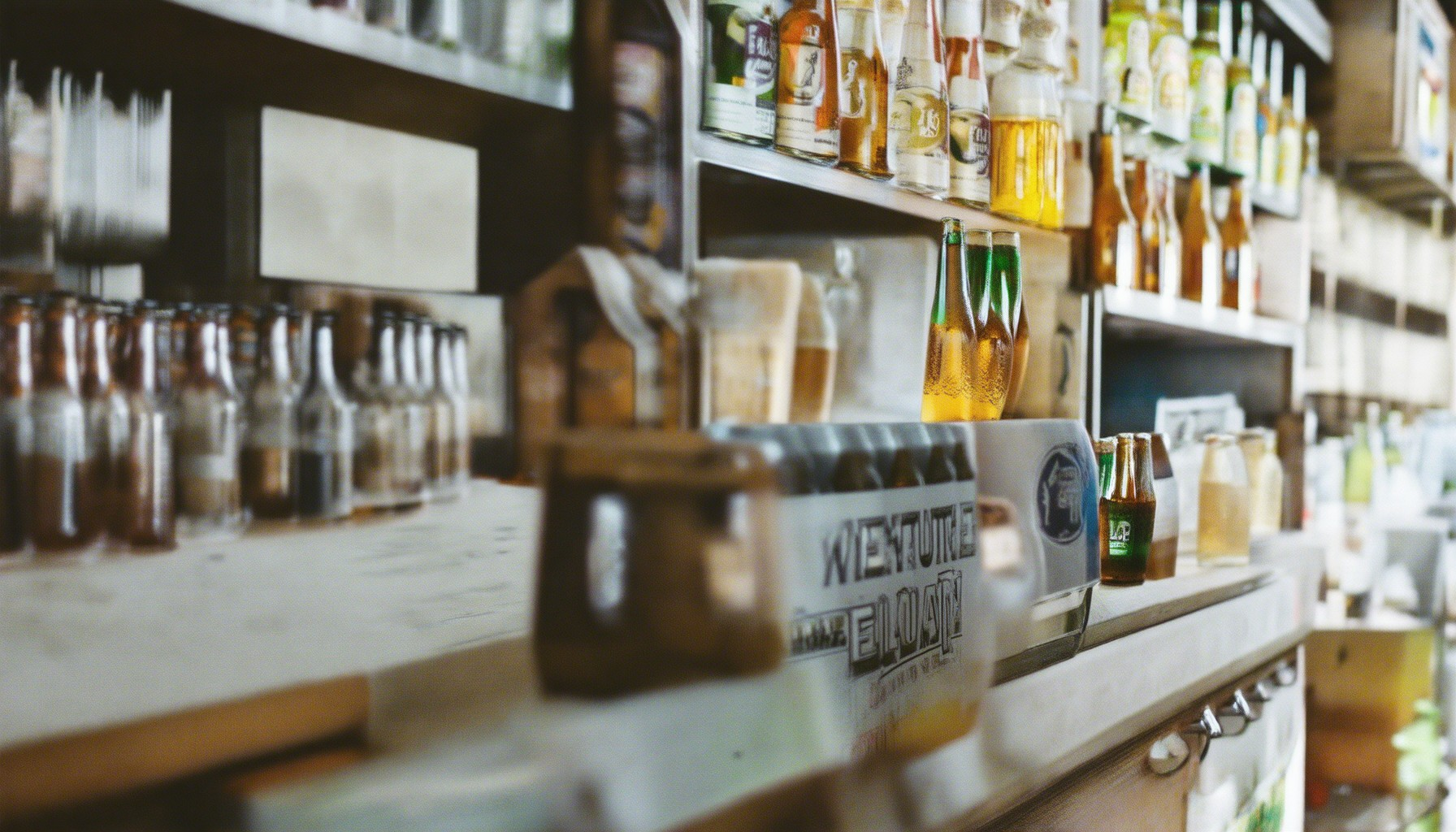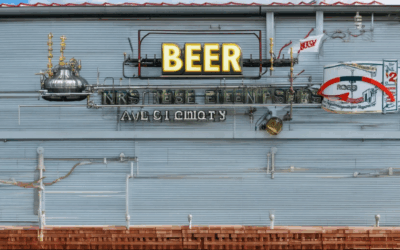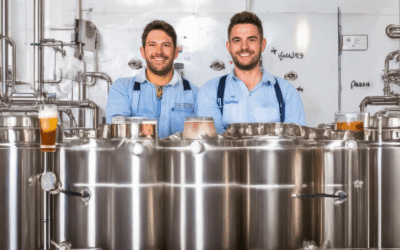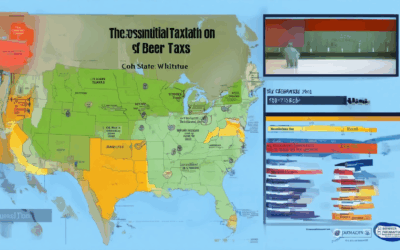The craft beer industry is highly competitive, with breweries vying for the attention of discerning consumers in a rapidly evolving market. Standing out in this crowded space requires a strategic approach to beer positioning that aligns with both market trends and consumer preferences. Whether it’s through crafting a unique brand identity, targeting the right audience, or leveraging innovative practices, successful beer branding demands a deep understanding of the market dynamics and a clear vision for differentiation. In this comprehensive guide, we’ll explore proven strategies to elevate your beer brand positioning, ensuring your product captures the attention of your target audience and carves a niche in the competitive landscape.

Effective Strategies for Positioning Your Beer Brand in the Market
- Understand Your Audience
- Conduct consumer surveys and market research to identify preferences and demographics.
- Leverage social media analytics to track engagement and feedback.
- Create buyer personas to tailor marketing efforts to specific segments.
- Highlight Unique Selling Points
- Emphasize quality, craftsmanship, and sustainability in your production process.
- Differentiate through innovative flavors, packaging, or storytelling.
- Offer limited editions or seasonal beers to create exclusivity and demand.
- Build a Strong Brand Identity
- Develop a unique brand name, logo, and color scheme that resonates with your target audience.
- Invest in professional photography and branding materials for consistency.
- Storytelling through your brand history and mission statement can foster emotional connection.
- Implement Targeted Marketing Campaigns
- Use social media platforms like Instagram and TikTok to showcase your products and culture.
- Partner with influencers or bloggers in the food and beverage space.
- Sponsor local events or festivals to gain visibility in your target markets.
- Engage With Customers
- Respond to customer inquiries and feedback promptly via email or social media.
- Create a loyalty program to reward repeat customers and encourage referrals.
- Host virtual or in-person tasting sessions to educate consumers about your beers.
- Monitor Competitors
- Use competitive analysis tools to track market share and pricing strategies.
- Benchmark your products against leading competitors in terms of taste, quality, and price.
- Stay updated on industry trends to adapt your strategies accordingly.
- Invest in Quality and Innovation
- Focus on ingredient sourcing and brewing techniques to maintain premium quality.
- Pursue certifications like USDA Organic or Fair Trade to differentiate your brand.
- Experiment with new flavor profiles and brewing methods to stay ahead of trends.
- Leverage Technology
- Utilize CRM systems to manage customer relationships and marketing campaigns.
- Integrate data analytics to track campaign performance and customer behavior.
- Implement e-commerce solutions for direct-to-consumer sales channels.
- Focus on Sustainability
- Adopt eco-friendly packaging options to appeal to environmentally conscious consumers.
- Participate in carbon neutrality initiatives to reduce your environmental footprint.
- Educate consumers about your sustainable practices through transparent communication.
- Build a Community
- Foster a loyal community through social media groups, forums, and events.
- Collaborate with local breweries or bars to create a network of supporters.
- Encourage user-generated content to amplify your brand’s visibility.
- Explore International Markets
- Research global beer cultures to adapt your products for international success.
- Participate in export promotion programs to enter new markets.
- Localize your marketing efforts to resonate with regional preferences.
- Stay Flexible and Adaptable
- Be open to feedback and willing to make adjustments based on market response.
- Monitor consumer sentiment and adjust your strategies to remain relevant.
- Keep pace with evolving consumer preferences and industry trends.
- Measure and Optimize
- Track key performance indicators such as sales growth, customer acquisition cost, and brand awareness.
- Use A/B testing to optimize marketing messages and packaging designs.
- Regularly audit your digital presence to ensure it aligns with brand objectives.
- Build Partnerships
- Collaborate with local retailers, distributors, and wholesalers to expand distribution channels.
- Form strategic alliances with complementary businesses to leverage their networks.
- Work with event planners and promoters to secure high-profile brand placements.
- Focus on Brand Advocacy
- Turn satisfied customers into advocates by offering referral programs and exclusive perks.
- Encourage positive reviews and testimonials on your website and social media.
- Engage with customers on platforms like Yelp, Google My Business, and Facebook to manage your brand reputation.
- Invest in Education
- Provide resources like brewing guides or beer pairing tips to add value to your brand.
- Sponsor educational workshops or events focused on beer appreciation.
- Share behind-the-scenes content to give consumers insight into your production process.
- Consider Seasonal and Thematic Campaigns
- Run campaigns tied to holidays, festivals, or seasonal events to capture attention.
- Themed campaigns around specific beer styles or ingredients can drive interest.
- Seasonal promotions can boost sales and create buzz around your brand.
- Optimize Online Presence
- Ensure your website is mobile-friendly and loaded with relevant content.
- Claim and optimize your Google My Business profile for local visibility.
- Use SEO best practices to improve your search engine ranking and drive organic traffic.
- Focus on Packaging and Presentation
- Invest in eye-catching packaging designs that reflect your brand identity.
- Use recyclable and biodegradable materials to appeal to eco-conscious consumers.
- Highlight product details like ABV, IBU, and flavor notes on packaging.
- Engage in Cross-Promotions
- Collaborate with other beverage brands for co-branded promotions.
- Offer discounts or special deals when purchasing multiple products.
- Participate in bundle deals or gift packs to increase sales opportunities.
- Stay Ahead of Trends
- Monitor industry trends to identify emerging consumer preferences.
- Experiment with new beer styles and flavor innovations.
- Adapt your branding and marketing strategies to align with current trends.
- Focus on Local and Regional Marketing
- Participate in local beer festivals and trade shows to build brand awareness.
- Collaborate with local restaurants and bars to feature your beers on tap.
- Run localized marketing campaigns tailored to specific regions.
- Build a Long-Term Vision
- Develop a strategic plan for sustained growth and market leadership.
- Invest in R&D to explore new markets and product categories.
- Establish partnerships with industry leaders to drive innovation.
- Measure Customer Loyalty
- Use loyalty programs and surveys to gauge customer satisfaction.
- Analyze feedback to identify areas for improvement and opportunities for differentiation.
- Act on customer complaints and concerns promptly to maintain trust.
- Explore Collaborations
- Partner with other brewers for collaborative brews or guest tapping programs.
- Collaborate with chefs or mixologists to create unique beer-based recipes.
- Join forces with other brands for joint marketing campaigns.
- Focus on Distribution Channels
- Develop strong relationships with reliable distributors and retailers.
- Expand distribution networks to reach new markets efficiently.
- Ensure consistent product availability across all sales channels.
- Stay Committed to Quality Control
- Maintain rigorous quality control standards throughout production.
- Implement quality assurance programs to minimize defects and inconsistencies.
- Use advanced equipment and technologies to enhance brewing precision.
- Focus on Brand Consistency
- Ensure all branding materials, packaging, and promotional content align with your brand identity.
- Train staff and partners to deliver a consistent brand experience.
- Monitor brand consistency across all touchpoints to maintain a cohesive image.
- Explore New Revenue Streams
- Offer merchandise, subscriptions, or membership programs to diversify income.
- Develop a beer delivery service or subscription model for convenience.
- Explore partnerships with hotels, restaurants, and event venues for additional revenue.
- Stay Updated on Regulations
- Comply with local, state, and federal regulations regarding alcohol production and distribution.
- Stay informed about changes in regulations that may impact your operations.
- Consult legal experts to ensure compliance with all relevant laws and standards.
- Focus on Employee Development
- Invest in training programs to enhance employee skills and knowledge.
- Encourage a culture of continuous learning and innovation among employees.
- Provide opportunities for advancement and career growth within the company.
- Explore Digital Transformation
- Adopt digital tools and platforms to streamline operations and improve efficiency.
- Use data analytics to drive decision-making and optimize performance.
- Implement e-commerce solutions to expand online sales channels.
- Stay Connected with Industry Leaders
- Attend industry conferences and networking events to build relationships.
- Join professional organizations and associations to access valuable resources.
- Seek mentorship and advice from experienced industry professionals.
- Focus on Environmental Responsibility
- Reduce waste in production processes through lean manufacturing techniques.
- Implement energy-efficient technologies to lower operational costs.
- Pledge to carbon-neutral production and offset carbon emissions.
- Engage in Philanthropy
- Support local communities through charitable donations and volunteer activities.
- Partner with non-profits aligned with your brand values to build corporate social responsibility.
- Run fundraising campaigns to support causes that align with your brand mission.
- Monitor Market Trends
- Stay informed about shifts in consumer preferences and market demands.
- Use trend analysis tools to anticipate future market needs.
- Adjust your strategies proactively to stay ahead of competition.
- Focus on Brand Legacy
- Build a long-term vision for your brand beyond short-term gains.
- Cultivate a legacy of quality, innovation, and community involvement.
- Plan for succession and continuity to ensure the brand’s enduring success.
For more insights into crafting a successful beer brand strategy, explore The Goods On Tap ’s comprehensive brewery reviews and industry trends coverage.
Effective Strategies for Positioning Your Beer Brand in the Market
- Understand Your Audience
- Conduct consumer surveys and market research to identify preferences and demographics.
- Leverage social media analytics to track engagement and feedback.
- Create buyer personas to tailor marketing efforts to specific segments.
- Highlight Unique Selling Points
- Emphasize quality, craftsmanship, and sustainability in your production process.
- Differentiate through innovative flavors, packaging, or storytelling.
- Offer limited editions or seasonal beers to create exclusivity and demand.
- Build a Strong Brand Identity
- Develop a unique brand name, logo, and color scheme that resonates with your target audience.
- Invest in professional photography and branding materials for consistency.
- Storytelling through your brand history and mission statement can foster emotional connection.
- Implement Targeted Marketing Campaigns
- Use social media platforms like Instagram and TikTok to showcase your products and culture.
- Partner with influencers or bloggers in the food and beverage space.
- Sponsor local events or festivals to gain visibility in your target markets.
- Engage With Customers
- Respond to customer inquiries and feedback promptly via email or social media.
- Create a loyalty program to reward repeat customers and encourage referrals.
- Host virtual or in-person tasting sessions to educate consumers about your beers.
- Monitor Competitors
- Use competitive analysis tools to track market share and pricing strategies.
- Benchmark your products against leading competitors in terms of taste, quality, and price.
- Stay updated on industry trends to adapt your strategies accordingly.
- Invest in Quality and Innovation
- Focus on ingredient sourcing and brewing techniques to maintain premium quality.
- Pursue certifications like USDA Organic or Fair Trade to differentiate your brand.
- Experiment with new flavor profiles and brewing methods to stay ahead of trends.
- Leverage Technology
- Utilize CRM systems to manage customer relationships and marketing campaigns.
- Integrate data analytics to track campaign performance and customer behavior.
- Implement e-commerce solutions for direct-to-consumer sales channels.
- Focus on Sustainability
- Adopt eco-friendly packaging options to appeal to environmentally conscious consumers.
- Participate in carbon neutrality initiatives to reduce your environmental footprint.
- Educate consumers about your sustainable practices through transparent communication.
- Build a Community
- Foster a loyal community through social media groups, forums, and events.
- Collaborate with local breweries or bars to create a network of supporters.
- Encourage user-generated content to amplify your brand’s visibility.
- Explore International Markets
- Research global beer cultures to adapt your products for international success.
- Participate in export promotion programs to enter new markets.
- Localize your marketing efforts to resonate with regional preferences.
- Stay Flexible and Adaptable
- Be open to feedback and willing to make adjustments based on market response.
- Monitor consumer sentiment and adjust your strategies to remain relevant.
- Keep pace with evolving consumer preferences and industry trends.
- Measure and Optimize
- Track key performance indicators such as sales growth, customer acquisition cost, and brand awareness.
- Use A/B testing to optimize marketing messages and packaging designs.
- Regularly audit your digital presence to ensure it aligns with brand objectives.
- Build Partnerships
- Collaborate with local retailers, distributors, and wholesalers to expand distribution channels.
- Form strategic alliances with complementary businesses to leverage their networks.
- Work with event planners and promoters to secure high-profile brand placements.
- Focus on Brand Advocacy
- Turn satisfied customers into advocates by offering referral programs and exclusive perks.
- Encourage positive reviews and testimonials on your website and social media.
- Engage with customers on platforms like Yelp, Google My Business, and Facebook to manage your brand reputation.
- Invest in Education
- Provide resources like brewing guides or beer pairing tips to add value to your brand.
- Sponsor educational workshops or events focused on beer appreciation.
- Share behind-the-scenes content to give consumers insight into your production process.
- Consider Seasonal and Thematic Campaigns
- Run campaigns tied to holidays, festivals, or seasonal events to capture attention.
- Themed campaigns around specific beer styles or ingredients can drive interest.
- Seasonal promotions can boost sales and create buzz around your brand.
- Optimize Online Presence
- Ensure your website is mobile-friendly and loaded with relevant content.
- Claim and optimize your Google My Business profile for local visibility.
- Use SEO best practices to improve your search engine ranking and drive organic traffic.
- Focus on Packaging and Presentation
- Invest in eye-catching packaging designs that reflect your brand identity.
- Use recyclable and biodegradable materials to appeal to eco-conscious consumers.
- Highlight product details like ABV, IBU, and flavor notes on packaging.
- Engage in Cross-Promotions
- Collaborate with other beverage brands for co-branded promotions.
- Offer discounts or special deals when purchasing multiple products.
- Participate in bundle deals or gift packs to increase sales opportunities.
- Stay Ahead of Trends
- Monitor industry trends to identify emerging consumer preferences.
- Experiment with new beer styles and flavor innovations.
- Adapt your branding and marketing strategies to align with current trends.
- Focus on Local and Regional Marketing
- Participate in local beer festivals and trade shows to build brand awareness.
- Collaborate with local restaurants and bars to feature your beers on tap.
- Run localized marketing campaigns tailored to specific regions.
- Build a Long-Term Vision
- Develop a strategic plan for sustained growth and market leadership.
- Invest in R&D to explore new markets and product categories.
- Establish partnerships with industry leaders to drive innovation.
- Measure Customer Loyalty
- Use loyalty programs and surveys to gauge customer satisfaction.
- Analyze feedback to identify areas for improvement and opportunities for differentiation.
- Act on customer complaints and concerns promptly to maintain trust.
- Explore Collaborations
- Partner with other brewers for collaborative brews or guest tapping programs.
- Collaborate with chefs or mixologists to create unique beer-based recipes.
- Join forces with other brands for joint marketing campaigns.
- Focus on Distribution Channels
- Develop strong relationships with reliable distributors and retailers.
- Expand distribution networks to reach new markets efficiently.
- Ensure consistent product availability across all sales channels.
- Stay Committed to Quality Control
- Maintain rigorous quality control standards throughout production.
- Implement quality assurance programs to minimize defects and inconsistencies.
- Use advanced equipment and technologies to enhance brewing precision.
- Focus on Brand Consistency
- Ensure all branding materials, packaging, and promotional content align with your brand identity.
- Train staff and partners to deliver a consistent brand experience.
- Monitor brand consistency across all touchpoints to maintain a cohesive image.
- Explore New Revenue Streams
- Offer merchandise, subscriptions, or membership programs to diversify income.
- Develop a beer delivery service or subscription model for convenience.
- Explore partnerships with hotels, restaurants, and event venues for additional revenue.
- Stay Updated on Regulations
- Comply with local, state, and federal regulations regarding alcohol production and distribution.
- Stay informed about changes in regulations that may impact your operations.
- Consult legal experts to ensure compliance with all relevant laws and standards.
- Focus on Employee Development
- Invest in training programs to enhance employee skills and knowledge.
- Encourage a culture of continuous learning and innovation among employees.
- Provide opportunities for advancement and career growth within the company.
- Explore Digital Transformation
- Adopt digital tools and platforms to streamline operations and improve efficiency.
- Use data analytics to drive decision-making and optimize performance.
- Implement e-commerce solutions to expand online sales channels.
- Stay Connected with Industry Leaders
- Attend industry conferences and networking events to build relationships.
- Join professional organizations and associations to access valuable resources.
- Seek mentorship and advice from experienced industry professionals.
- Focus on Environmental Responsibility
- Reduce waste in production processes through lean manufacturing techniques.
- Implement energy-efficient technologies to lower operational costs.
- Pledge to carbon-neutral production and offset carbon emissions.
- Engage in Philanthropy
- Support local communities through charitable donations and volunteer activities.
- Partner with non-profits aligned with your brand values to build corporate social responsibility.
- Run fundraising campaigns to support causes that align with your brand mission.
- Monitor Market Trends
- Stay informed about shifts in consumer preferences and market demands.
- Use trend analysis tools to anticipate future market needs.
- Adjust your strategies proactively to stay ahead of competition.
- Focus on Brand Legacy
- Build a long-term vision for your brand beyond short-term gains.
- Cultivate a legacy of quality, innovation, and community involvement.
- Plan for succession and continuity to ensure the brand’s enduring success.
For more insights into crafting a successful beer brand strategy, explore The Goods On Tap ’s comprehensive brewery reviews and industry trends coverage.

How Can You Effectively Position Your Beer Brand in the Market?
To effectively position your beer brand in the market, consider implementing the following strategies:
- Understand Your Audience : Begin by identifying your target demographic. Tailor your branding, messaging, and product offerings to meet the preferences and needs of your audience. For instance, craft beer enthusiasts may appreciate unique flavors and artisanal packaging, while a broader market might respond to classic, easily accessible options.
- Develop a Unique Selling Proposition (USP) : Identify what sets your beer apart from competitors. This could be the quality of ingredients, the brewing process, or a distinctive flavor profile. Highlighting this unique attribute will help differentiate your brand in the market.
- Build Strong Brand Identity : Create a cohesive brand image that reflects the personality of your beer. This includes your logo, color scheme, typography, and overall aesthetic. Consistency in branding across all platforms ensures recognition and builds trust among consumers.
- Focus on Quality Control : Implement rigorous quality control measures to ensure that every batch of beer meets high standards. Consistency in taste, texture, and appearance will enhance customer loyalty and reinforce brand reliability.
- Leverage Distribution Channels : Partner with the right retail outlets, bars, and restaurants to ensure your beer reaches the intended audience. Consider collaborating with local businesses or participating in beer festivals to increase visibility.
- Engage in Social Media and Digital Marketing : Utilize social media platforms to connect with your audience, share behind-the-scenes content, and promote special offers. Running targeted ads based on demographics and interests can help reach potential customers effectively.
- Innovate in Packaging : Invest in creative packaging solutions that align with your brand identity. Eco-friendly materials or unique bottle designs can make your beer stand out on store shelves.
- Form Strategic Partnerships : Collaborate with local breweries, suppliers, or small businesses to leverage shared resources and expand your reach. Co-branded events or joint promotions can mutually benefit both parties.
- Monitor Competitors and Stay Adaptive : Keep an eye on the market and your competitors. Adapt your strategies based on their movements and consumer feedback. Being innovative and responsive will help you maintain a competitive edge.
By combining these strategies, you can create a beer brand that not only stands out but also resonates deeply with its target audience, driving long-term success in the market.

Effective Strategies for Positioning Your Beer Brand in the Market
- Understand Your Audience
- Conduct consumer surveys and market research to identify preferences and demographics.
- Leverage social media analytics to track engagement and feedback.
- Create buyer personas to tailor marketing efforts to specific segments.
- Highlight Unique Selling Points
- Emphasize quality, craftsmanship, and sustainability in your production process.
- Differentiate through innovative flavors, packaging, or storytelling.
- Offer limited editions or seasonal beers to create exclusivity and demand.
- Build a Strong Brand Identity
- Develop a unique brand name, logo, and color scheme that resonates with your target audience.
- Invest in professional photography and branding materials for consistency.
- Storytelling through your brand history and mission statement can foster emotional connection.
- Implement Targeted Marketing Campaigns
- Use social media platforms like Instagram and TikTok to showcase your products and culture.
- Partner with influencers or bloggers in the food and beverage space.
- Sponsor local events or festivals to gain visibility in your target markets.
- Engage With Customers
- Respond to customer inquiries and feedback promptly via email or social media.
- Create a loyalty program to reward repeat customers and encourage referrals.
- Host virtual or in-person tasting sessions to educate consumers about your beers.
- Monitor Competitors
- Use competitive analysis tools to track market share and pricing strategies.
- Benchmark your products against leading competitors in terms of taste, quality, and price.
- Stay updated on industry trends to adapt your strategies accordingly.
- Invest in Quality and Innovation
- Focus on ingredient sourcing and brewing techniques to maintain premium quality.
- Pursue certifications like USDA Organic or Fair Trade to differentiate your brand.
- Experiment with new flavor profiles and brewing methods to stay ahead of trends.
- Leverage Technology
- Utilize CRM systems to manage customer relationships and marketing campaigns.
- Integrate data analytics to track campaign performance and customer behavior.
- Implement e-commerce solutions for direct-to-consumer sales channels.
- Focus on Sustainability
- Adopt eco-friendly packaging options to appeal to environmentally conscious consumers.
- Participate in carbon neutrality initiatives to reduce your environmental footprint.
- Educate consumers about your sustainable practices through transparent communication.
- Build a Community
- Foster a loyal community through social media groups, forums, and events.
- Collaborate with local breweries or bars to create a network of supporters.
- Encourage user-generated content to amplify your brand’s visibility.
- Explore International Markets
- Research global beer cultures to adapt your products for international success.
- Participate in export promotion programs to enter new markets.
- Localize your marketing efforts to resonate with regional preferences.
- Stay Flexible and Adaptable
- Be open to feedback and willing to make adjustments based on market response.
- Monitor consumer sentiment and adjust your strategies to remain relevant.
- Keep pace with evolving consumer preferences and industry trends.
- Measure and Optimize
- Track key performance indicators such as sales growth, customer acquisition cost, and brand awareness.
- Use A/B testing to optimize marketing messages and packaging designs.
- Regularly audit your digital presence to ensure it aligns with brand objectives.
- Build Partnerships
- Collaborate with local retailers, distributors, and wholesalers to expand distribution channels.
- Form strategic alliances with complementary businesses to leverage their networks.
- Work with event planners and promoters to secure high-profile brand placements.
- Focus on Brand Advocacy
- Turn satisfied customers into advocates by offering referral programs and exclusive perks.
- Encourage positive reviews and testimonials on your website and social media.
- Engage with customers on platforms like Yelp, Google My Business, and Facebook to manage your brand reputation.
- Invest in Education
- Provide resources like brewing guides or beer pairing tips to add value to your brand.
- Sponsor educational workshops or events focused on beer appreciation.
- Share behind-the-scenes content to give consumers insight into your production process.
- Consider Seasonal and Thematic Campaigns
- Run campaigns tied to holidays, festivals, or seasonal events to capture attention.
- Themed campaigns around specific beer styles or ingredients can drive interest.
- Seasonal promotions can boost sales and create buzz around your brand.
- Optimize Online Presence
- Ensure your website is mobile-friendly and loaded with relevant content.
- Claim and optimize your Google My Business profile for local visibility.
- Use SEO best practices to improve your search engine ranking and drive organic traffic.
- Focus on Packaging and Presentation
- Invest in eye-catching packaging designs that reflect your brand identity.
- Use recyclable and biodegradable materials to appeal to eco-conscious consumers.
- Highlight product details like ABV, IBU, and flavor notes on packaging.
- Engage in Cross-Promotions
- Collaborate with other beverage brands for co-branded promotions.
- Offer discounts or special deals when purchasing multiple products.
- Participate in bundle deals or gift packs to increase sales opportunities.
- Stay Ahead of Trends
- Monitor industry trends to identify emerging consumer preferences.
- Experiment with new beer styles and flavor innovations.
- Adapt your branding and marketing strategies to align with current trends.
- Focus on Local and Regional Marketing
- Participate in local beer festivals and trade shows to build brand awareness.
- Collaborate with local restaurants and bars to feature your beers on tap.
- Run localized marketing campaigns tailored to specific regions.
- Build a Long-Term Vision
- Develop a strategic plan for sustained growth and market leadership.
- Invest in R&D to explore new markets and product categories.
- Establish partnerships with industry leaders to drive innovation.
- Measure Customer Loyalty
- Use loyalty programs and surveys to gauge customer satisfaction.
- Analyze feedback to identify areas for improvement and opportunities for differentiation.
- Act on customer complaints and concerns promptly to maintain trust.
- Explore Collaborations
- Partner with other brewers for collaborative brews or guest tapping programs.
- Collaborate with chefs or mixologists to create unique beer-based recipes.
- Join forces with other brands for joint marketing campaigns.
- Focus on Distribution Channels
- Develop strong relationships with reliable distributors and retailers.
- Expand distribution networks to reach new markets efficiently.
- Ensure consistent product availability across all sales channels.
- Stay Committed to Quality Control
- Maintain rigorous quality control standards throughout production.
- Implement quality assurance programs to minimize defects and inconsistencies.
- Use advanced equipment and technologies to enhance brewing precision.
- Focus on Brand Consistency
- Ensure all branding materials, packaging, and promotional content align with your brand identity.
- Train staff and partners to deliver a consistent brand experience.
- Monitor brand consistency across all touchpoints to maintain a cohesive image.
- Explore New Revenue Streams
- Offer merchandise, subscriptions, or membership programs to diversify income.
- Develop a beer delivery service or subscription model for convenience.
- Explore partnerships with hotels, restaurants, and event venues for additional revenue.
- Stay Updated on Regulations
- Comply with local, state, and federal regulations regarding alcohol production and distribution.
- Stay informed about changes in regulations that may impact your operations.
- Consult legal experts to ensure compliance with all relevant laws and standards.
- Focus on Employee Development
- Invest in training programs to enhance employee skills and knowledge.
- Encourage a culture of continuous learning and innovation among employees.
- Provide opportunities for advancement and career growth within the company.
- Explore Digital Transformation
- Adopt digital tools and platforms to streamline operations and improve efficiency.
- Use data analytics to drive decision-making and optimize performance.
- Implement e-commerce solutions to expand online sales channels.
- Stay Connected with Industry Leaders
- Attend industry conferences and networking events to build relationships.
- Join professional organizations and associations to access valuable resources.
- Seek mentorship and advice from experienced industry professionals.
- Focus on Environmental Responsibility
- Reduce waste in production processes through lean manufacturing techniques.
- Implement energy-efficient technologies to lower operational costs.
- Pledge to carbon-neutral production and offset carbon emissions.
- Engage in Philanthropy
- Support local communities through charitable donations and volunteer activities.
- Partner with non-profits aligned with your brand values to build corporate social responsibility.
- Run fundraising campaigns to support causes that align with your brand mission.
- Monitor Market Trends
- Stay informed about shifts in consumer preferences and market demands.
- Use trend analysis tools to anticipate future market needs.
- Adjust your strategies proactively to stay ahead of competition.
- Focus on Brand Legacy
- Build a long-term vision for your brand beyond short-term gains.
- Cultivate a legacy of quality, innovation, and community involvement.
- Plan for succession and continuity to ensure the brand’s enduring success.
For more insights into crafting a successful beer brand strategy, explore The Goods On Tap ’s comprehensive brewery reviews and industry trends coverage.
How Can You Effectively Position Your Beer Brand in the Market?
To effectively position your beer brand in the market, consider implementing the following strategies:
- Understand Your Audience : Begin by identifying your target demographic. Tailor your branding, messaging, and product offerings to meet the preferences and needs of your audience. For instance, craft beer enthusiasts may appreciate unique flavors and artisanal packaging, while a broader market might respond to classic, easily accessible options.
- Develop a Unique Selling Proposition (USP) : Identify what sets your beer apart from competitors. This could be the quality of ingredients, the brewing process, or a distinctive flavor profile. Highlighting this unique attribute will help differentiate your brand in the market.
- Build Strong Brand Identity : Create a cohesive brand image that reflects the personality of your beer. This includes your logo, color scheme, typography, and overall aesthetic. Consistency in branding across all platforms ensures recognition and builds trust among consumers.
- Focus on Quality Control : Implement rigorous quality control measures to ensure that every batch of beer meets high standards. Consistency in taste, texture, and appearance will enhance customer loyalty and reinforce brand reliability.
- Leverage Distribution Channels : Partner with the right retail outlets, bars, and restaurants to ensure your beer reaches the intended audience. Consider collaborating with local businesses or participating in beer festivals to increase visibility.
- Engage in Social Media and Digital Marketing : Utilize social media platforms to connect with your audience, share behind-the-scenes content, and promote special offers. Running targeted ads based on demographics and interests can help reach potential customers effectively.
- Innovate in Packaging : Invest in creative packaging solutions that align with your brand identity. Eco-friendly materials or unique bottle designs can make your beer stand out on store shelves.
- Form Strategic Partnerships : Collaborate with local breweries, suppliers, or small businesses to leverage shared resources and expand your reach. Co-branded events or joint promotions can mutually benefit both parties.
- Monitor Competitors and Stay Adaptive : Keep an eye on the market and your competitors. Adapt your strategies based on their movements and consumer feedback. Being innovative and responsive will help you maintain a competitive edge.
By combining these strategies, you can create a beer brand that not only stands out but also resonates deeply with its target audience, driving long-term success in the market.

Effective Methods for Positioning Your Beer Brand in the Market
To successfully position your beer brand in the competitive craft beer market, consider implementing the following strategies:
1. Understand Your Audience
- Identify Target Consumers: Tailor your branding and marketing efforts to appeal to your primary audience. Consider factors like age, location, preferences, and lifestyle.
- Segment Your Market: Divide your audience into smaller groups based on demographics, interests, or purchasing habits to tailor your approach.
2. Develop a Unique Brand Identity
- Brand Story and Mission: Craft a compelling narrative that reflects your brand values and mission. Share this story across all platforms to build trust and loyalty.
- Sustainable Practices: Highlight your commitment to sustainability, whether through eco-friendly packaging, energy-efficient processes, or charitable giving programs.
- Local Partnerships: Collaborate with local breweries, suppliers, or community organizations to strengthen your brand’s authenticity and credibility.
3. Create a Strong Visual Identity
- Logo and Design: Ensure your logo, color scheme, and typography align with your brand values and resonate with your target audience.
- Packaging and Labeling: Use eye-catching labels and packaging that convey quality and uniqueness. Consider biodegradable or recyclable materials for added appeal.
4. Build Emotional Connections
- Storytelling: Share stories about your brand, your team, or the craftsmanship behind your beers to create an emotional bond with your customers.
- Community Building: Host events, workshops, or tastings to bring your community together and foster a sense of belonging.
5. Leverage Social Media
- Engage on Platforms: Use platforms like Instagram, Facebook, and Twitter to share updates, behind-the-scenes content, and interact with followers.
- Influencer Collaborations: Partner with micro-influencers or bloggers who have a strong following in the craft beer space to reach a targeted audience.
- Content Strategy: Post consistently, share educational content about beer, and showcase your products in creative ways to capture attention.
6. Emphasize Sustainability
- Eco-Friendly Practices: Highlight your commitment to reducing environmental impact through sustainable brewing practices and packaging choices.
- Charitable Initiatives: Donate a portion of sales or participate in fundraising efforts for causes that align with your brand values.
- limited Editions: Offer special editions or seasonal beers that highlight your dedication to innovation and community support.
7. Innovate and Stay Relevant
- Experiment with Flavors: Constantly innovate with new flavor profiles and brewing techniques to keep your offerings fresh and exciting.
- Stay Updated on Trends: Monitor industry trends and consumer preferences to adjust your strategies accordingly and remain competitive.
- Customer Feedback: Gather feedback through surveys, social media, and tasting events to understand what your customers want and how you can improve.
8. Establish a Competitive Pricing Strategy
- Competitive yet Profitable Pricing: Balance your pricing to stay competitive without compromising on quality or margins.
- Pricing Tiers: Offer different price points to cater to various consumer budgets, ensuring accessibility while maintaining brand integrity.
9. Optimize Distribution Channels
- DTC Model: Explore direct-to-consumer channels like your own website, pop-up shops, or subscription services for greater control and customer engagement.
- Retail Partnerships: Collaborate with local bottle shops, bars, and restaurants to increase visibility and access to your products.
10. Monitor and Adapt
- Continuous Monitoring: Track your brand’s performance through sales data, customer feedback, and market trends to identify areas of improvement.
- A/B Testing: Experiment with different marketing tactics and packaging designs to determine what resonates most with your audience.
- Customer Engagement: Respond to inquiries, reviews, and feedback promptly to build trust and loyalty.
Conclusion
By focusing on these strategies, you can differentiate your beer brand and carve out a unique niche in the market. Remember to stay authentic, innovative, and committed to your values to build lasting connections with your customers.





0 Comments